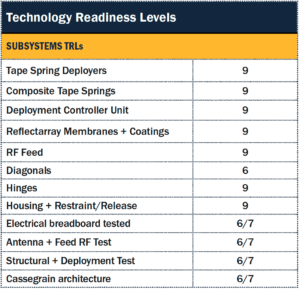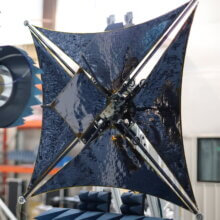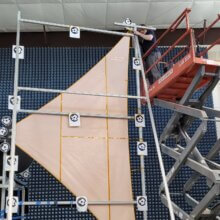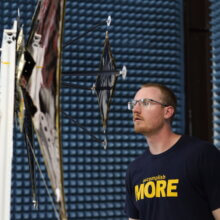Low Inertia, High Bandwidth
The patented T-DaHGR antenna provides performance equivalent to a conventional parabolic antenna, but with significant advantages in compaction, simplicity, scalability and cost for wide band, multi-band, communications or SAR applications. MMA has been developing both a 0.7- meter and scaled-up 5-meter T-DaHGR with funding from the Air Force Research Laboratory, has successfully tested, and identified a mission for this disruptive, deployable, membrane-based reflectarray antenna.
- 0.7 meter T-DaHGR antenna at the RF testing range.
- 5 meter T-DaHGR at the RF testing range.
- Colin inspects the 0.7 meter T-DaHGR. This angle shows the antenna’s parabolic shape.
RF Performance
The T-DaHGR antenna achieves high bandwidths due to its “shaped” deployment approximating a true parabola. Reflectarrays are commonly deployed as a single facet; however, the T-DaHGR approach enables multi-faceted implementations to enhance overall system performance and especially bandwidth. The Cassegrain architecture allows this agile antenna to be body mounted on a spacecraft, reducing cost and complexity typically associated with booms and gimbals. The deployed accuracy of our 0.7- and 5-meter prototypes have achieved remarkable positional tolerances for both repeatability and alignment.
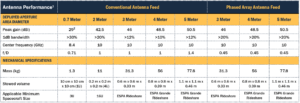
¹ 2-meter, 3-meter and 4-meter values are simulated, based on measured performance of a single facet 5M class reflectarray at X-band.
² Higher loss factor for panel gaps, tapes and microstrip feed.
Deployment Architecture
The Tape-Deployable High Gain Reflectarray, T-DaHGR, antenna uses flight heritage tape springs to tension the membranes and react structural loads. This spatially fed reflectarray enables very large apertures relative to its stowed volume, and can be configured to support wider bandwidth than traditional reflectarrays.
This antenna architecture leverages flight- and other rigorously-tested components and subsystems that MMA has used on flight heritage space power, deorbit and antenna systems, including thin-film membranes, tape spring deployers, hinges, deployment controller electronics and restraint / release systems.
T-DaHGR Antenna deployment sequence.

1. T-DaHGR stowed.
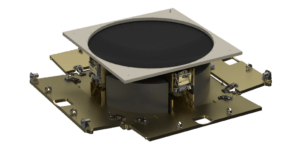
2. Lid/Subreflector released (switches on door hinges provide telemetry)

3. Deployed (lockout pins on TDAs provide telemetry).
T-DaHGR can be developed quickly and is an ideal choice for radar and communications applications where having high bandwidth and a lower center of gravity to the spacecraft are beneficial. The benefits of this highly scalable antenna architecture are numerous, but topping the list are its reliability and flexibility, enabling ultimate mission capability and spacecraft agility.
